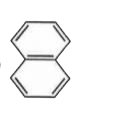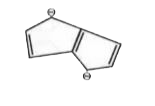Which of the following is non-polar but contains polar bonds?
HCl
CO2
NH3
NO2
The correct Answer is:B
To determine which of the following options is non-polar but contains polar bonds, we need to analyze the molecular structure and dipole moments of each option provided.
1. Understanding Non-Polar and Polar Bonds:
- A molecule is considered non-polar if the net dipole moment is zero, meaning that the individual dipole moments cancel each other out.
- A polar bond occurs when there is a difference in electronegativity between the two atoms involved in the bond, resulting in a dipole moment.
2. Analyzing Option A: HCl:
- HCl is a diatomic molecule with a significant difference in electronegativity between hydrogen and chlorine.
- This results in a dipole moment pointing from H (partially positive) to Cl (partially negative).
- Therefore, HCl is a polar molecule (dipole moment ≠ 0).
3. Analyzing Option B: CO2:
- CO2 has a linear structure with carbon in the center and two oxygen atoms on either side.
- Each C=O bond is polar due to the difference in electronegativity.
- However, the two dipole moments are equal in magnitude but opposite in direction, thus they cancel each other out.
- As a result, CO2 has a net dipole moment of zero, making it a non-polar molecule despite having polar bonds.
4. Analyzing Option C: NH3:
- NH3 (ammonia) has a trigonal pyramidal shape due to the presence of a lone pair on nitrogen.
- The N-H bonds are polar, and the dipole moments do not cancel out due to the molecular geometry.
- Therefore, NH3 is a polar molecule (dipole moment ≠ 0).
5. Analyzing Option D: NO2:
- NO2 has a bent shape due to the presence of a lone pair on nitrogen.
- The N-O bonds are polar, and the dipole moments do not cancel out, resulting in a net dipole moment.
- Hence, NO2 is also a polar molecule (dipole moment ≠ 0).
Conclusion:
The only molecule that is non-polar but contains polar bonds is Option B: CO2.
- A molecule is considered non-polar if the net dipole moment is zero, meaning that the individual dipole moments cancel each other out.
- A polar bond occurs when there is a difference in electronegativity between the two atoms involved in the bond, resulting in a dipole moment.
- HCl is a diatomic molecule with a significant difference in electronegativity between hydrogen and chlorine.
- This results in a dipole moment pointing from H (partially positive) to Cl (partially negative).
- Therefore, HCl is a polar molecule (dipole moment ≠ 0).
- CO2 has a linear structure with carbon in the center and two oxygen atoms on either side.
- Each C=O bond is polar due to the difference in electronegativity.
- However, the two dipole moments are equal in magnitude but opposite in direction, thus they cancel each other out.
- As a result, CO2 has a net dipole moment of zero, making it a non-polar molecule despite having polar bonds.
- NH3 (ammonia) has a trigonal pyramidal shape due to the presence of a lone pair on nitrogen.
- The N-H bonds are polar, and the dipole moments do not cancel out due to the molecular geometry.
- Therefore, NH3 is a polar molecule (dipole moment ≠ 0).
- NO2 has a bent shape due to the presence of a lone pair on nitrogen.
- The N-O bonds are polar, and the dipole moments do not cancel out, resulting in a net dipole moment.
- Hence, NO2 is also a polar molecule (dipole moment ≠ 0).
The only molecule that is non-polar but contains polar bonds is Option B: CO2.
Topper's Solved these Questions
- CHEMICAL BONDING-I & IIBOOK - VMC MODULES ENGLISHCHAPTER - CHEMICAL BONDING-I & IIEXERCISE - Level - 2 (JEE Advanced)
50 Videos
- CHEMICAL BONDING-I & IIBOOK - VMC MODULES ENGLISHCHAPTER - CHEMICAL BONDING-I & IIEXERCISE - JEE Main (Numerical Value Questions)
15 Videos
- CHEMICAL BONDING-I & IIBOOK - VMC MODULES ENGLISHCHAPTER - CHEMICAL BONDING-I & IIEXERCISE - Level - 0 (Long Answer Type)
4 Videos
- CHEMICAL BONDING & MOLECULAR STRUCTURE BOOK - VMC MODULES ENGLISHCHAPTER - CHEMICAL BONDING & MOLECULAR STRUCTURE EXERCISE - IN-CHAPTER EXERCISE-L
9 Videos
- CHEMICAL EQUILIBRIUMBOOK - VMC MODULES ENGLISHCHAPTER - CHEMICAL EQUILIBRIUMEXERCISE - IN-CHAPTER EXERCISE - G
10 Videos
Similar Questions
Knowledge Check
Which of the following is most polar?
A B
B C
C D
D
Which of the following is non polar species.
ASO2BCO2CH2ODNH3Which of the following is polar aprotic solvent ?
ADMSOBCrown ether:CDMGDAll of these
